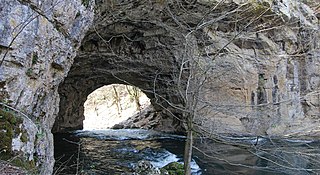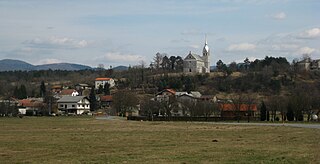
Postojna is a town in the traditional region of Inner Carniola, 35 kilometers (22 mi) from Trieste, in southwestern Slovenia. It is the seat of the Municipality of Postojna.

Cross Cave, also named Cold Cave under Cross Mountain, is a cave in Slovenia's Lož Valley. The cave is named after nearby Holy Cross Church in Podlož. The cave is particularly noted for its chain of over 45 subterranean lakes of emerald green water. With 45 species of organisms, some not discovered until 2000, Cross Cave is the fourth-largest cave ecosystem in the world in terms of biodiversity. The cave was first documented in 1832, but the part of the cave that includes lakes and stream passages was first explored by Slovene cavers in 1926. Over two thousand cave bear bones have been found in the cave.

Lake Cerknica is an intermittent lake in the southern part of the Cerknica Polje, a karst polje in Inner Carniola, a region in southwestern Slovenia. The lake, oriented in the Dinaric direction from northwest to southeast, is present for the most part of the year. When full, it is the largest lake in the country. The plain is surrounded by the Javornik Hills to the south and Slivnica to the north, both belonging to Dinaric Alps. The area of the lake mainly reaches 28 square kilometres (11 sq mi), but can reach up to 38 km2 (15 sq mi) and the surface level varies from 546 m (1,791 ft) to 551 m (1,808 ft) above sea level. The lake is an important wildlife resort, especially as a nesting place for many bird species. Botanically, it is distinguished by amphibious plants. It is therefore a part of two Natura 2000 areas of protection and the focus of the Inner Carniola Regional Park, which covers additional Natura 2000 areas in the broader region. The climate in the area is continental, with a mean temperature of 9.2 °C (48.6 °F) and the annual precipitation about 1,700 millimetres (67 in). The largest settlement at the border of the lake is Cerknica, located north of the lake. Various watersports, including rowing, are popular on the lake.

In geography, a confluence occurs where two or more flowing bodies of water join together to form a single channel. A confluence can occur in several configurations: at the point where a tributary joins a larger river ; or where two streams meet to become the source of a river of a new name ; or where two separated channels of a river rejoin at the downstream end.

Postojna Cave is a 24,340 m long karst cave system near Postojna, southwestern Slovenia. It is the second-longest cave system in the country as well as one of its top tourism sites. The caves were created by the Pivka River.

Petzen (German) or Peca (Slovene) is the highest mountain of the eastern Karawanks, the second-highest mountain of the Northern Karawanks and the most eastern two-thousand-metre mountain of Slovenia. It is a mighty mountain with a characteristic shape of a tableland with rocky peaks protruding from it. The mountain borders the Meža Valley and the Topla Valley to the south and east, and the Jaun Valley to the north, and is separated by the narrow valley of the Bela Creek from Hochobir. Two thirds of the mountain lies in Austria, and one third in Slovenia. The mountain reaches its highest elevation on the mountain crest of the Kordež Head. The border runs across it.

Rak Škocjan is a valley and a landscape park, part of Inner Carniola Regional Park in southwestern Slovenia. Administratively, it belongs to the settlement of Rakov Škocjan. Rak Škocjan has been protected since 1949 and is the oldest landscape park in Slovenia.

The Pivka is a karst lost river in Slovenia. The river is 27 kilometres (17 mi) in length. The Pivka ends in Planina Cave, where it merges with the Rak River and then the Unica River. The confluence of the Pivka and the Rak is one of the largest subterranean confluences in Europe. The Pivka created Postojna Cave, the longest cave system in Slovenia as well as one of its top tourism sites.

Planina is a village in the Municipality of Postojna in the Inner Carniola region of Slovenia. It includes the hamlets of Gornja Planina, Dolnja Planina, and Grič in the main settlement as well as Kačja Vas to the southwest and Malni and Hasberg to the south.

Trnje is a village east of Pivka in the Inner Carniola region of Slovenia.

Snežnik is a wide karst limestone plateau with an area of about 85 km2 (33 sq mi) in the Dinaric Alps. It can also be viewed as a southern extension of the Julian Alps. The main part of the plateau is in Slovenia, while the southern part extends into Croatia and connects to the mountain region of Gorski Kotar.

Rakov Škocjan is a settlement south of Rakek in the Municipality of Cerknica in the Inner Carniola region of Slovenia. The surrounding area of the Rak Škocjan Valley is a regional nature reserve known as Rak Škocjan Park.

Škocjan Caves is a cave system in Slovenia. Due to its exceptional significance, Škocjan Caves was entered on UNESCO’s list of natural and cultural world heritage sites in 1986. International scientific circles have thus acknowledged the importance of the caves as one of the natural treasures of planet Earth. Ranking among the most important caves in the world, Škocjan Caves represents the most significant underground phenomena both on the Karst Plateau and in Slovenia. Following independence from Yugoslavia in 1991, Slovenia committed itself to actively protecting the Škocjan Caves area and established Škocjan Caves Regional Park and its managing authority, the Škocjan Caves Park Public Service Agency.
Škocjan Caves Regional Park is located in the Škocjan Karst, a vast flat landscape that lies at an elevation between 420 and 450 m in the southeast part of the Karst area. Following its independence, the Slovenia committed itself to protecting the Škocjan Caves area; for this reason, it established Škocjan Caves Regional Park and its managing authority, the Škocjan Caves Park Public Service Agency.

Planina Cave, formerly also Little Castle Cave after Little Castle in the vicinity of its entrance, is one of the longest Slovenian water caves. It is a huge tunnel and the subterranean bed of the Unica River. It is located in Inner Carniola. Five hundred meters from the entrance into the cave is a confluence of two underground rivers: the Pivka River, flowing from the Postojna Polje through Postojna Cave, and the Rak River, flowing to Planina Cave through Weaver Cave from Rak Škocjan. This is one of the largest confluences of subterranean rivers in Europe.

The Municipality of Postojna is a municipality in the traditional region of Inner Carniola in southwestern Slovenia. The seat of the municipality is the town of Postojna. The municipality was established in its current form on 3 October 1994, when the former larger Municipality of Postojna was subdivided into the municipalities of Pivka and Postojna.

Weaver Cave, also known as Inlet Cave, is a 2,885 metres (9,465 ft) long ponor cave in southwest Slovenia. It runs from the west (downstream) side of the Rak Škocjan Valley, where it has two entrances, and continues into Planina Cave. It is traversed by Rak Creek, part of the Ljubljanica source system. It thus forms part of the hydrological connection between Cerknica Polje and Planina Polje. Due to sumps, the stream of the Rak is very difficult to follow and was explored by divers only in 1974, when the majority of the cave was discovered in the course of a rescue expedition, and in August 2012.

The Unica is a river in Slovenia. It starts as the underground confluence of the Pivka and the Rak in the Planina Cave. This is the largest confluence of underground rivers in Europe. 300 meters (980 ft) further, the Unica emerges near Planina. It then is about 10 kilometers (6.2 mi). It flows north through the Planina Karst Field through the municipalities of Postojna, Cerknica, and Logatec, where it returns underground. It then flows for about another 10 kilometers (6.2 mi) underground, emerging 142 meters (466 ft) lower at multiple springs near Vrhnika to form the Ljubljanica River.















